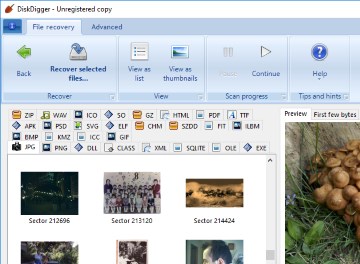News for December 2016: a big update!
 Today brings a very significant update to DiskDigger for Windows! The interface has been improved, with a stylish ribbon control that contains all the options and buttons you'll use for navigating and recovering your files. There are also improved "help" options every step of the way, with some of the most commonly-asked questions answered right inline.
Today brings a very significant update to DiskDigger for Windows! The interface has been improved, with a stylish ribbon control that contains all the options and buttons you'll use for navigating and recovering your files. There are also improved "help" options every step of the way, with some of the most commonly-asked questions answered right inline.
This update also has new features for advanced users and forensics specialists: the ability to save and restore "sessions" of data recovery (for scanning especially large drives over multiple sessions), as well as the ability to generate detailed reports of all the data that DiskDigger finds during a scan.
Here's a detailed list of all the new features and updates:
- Now using a Ribbon interface, which contains navigation (Back / Next) buttons, configuration settings, and recovery options.
- Every section of DiskDigger's workflow now has a "Help" button where you can find answers to common questions about the recovery process.
- In "dig deeper" mode, recoverable files are named in a more friendly way. Instead of naming them "Sector 12345", DiskDigger will try to name them based on any metadata that it finds within the files. For example, if a recoverable .JPG file contains a date stamp, it will be named "Photo taken on 2016-12-15". This will make it easier to sort through the list of recoverable files, and help you pinpoint the files you're looking for.
- In "dig deeper" mode, you can now save and restore sessions (in the Advanced tab).
- In both "deep" and "deeper" modes, you can now save a detailed report (in the Advanced tab) which is a log of all recoverable files found by DiskDigger, along with basic meta-information for each file.
- Improved support for scanning disk images. In the Advanced tab when selecting a drive, click the "Scan disk image" button. For forensic-strength scanning of disk images, you can control the number of bytes per sector (all the way down to 1), for recovering files that may not be aligned to sector boundaries.
- Added support for recovering raw images from Panasonic/Lumix cameras.
- As mentioned earlier, DiskDigger now requires .NET 4.0. Therefore, for running it on Windows XP or Windows Vista, you may need to install .NET 4.0 from Microsoft if you don't have it installed on your system.
Download DiskDigger now, and start recovering your files!
